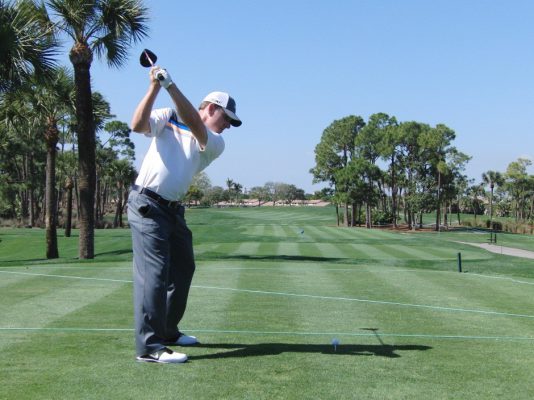2 to 1 is the Key to Power Coil in Your Golf Swing

by Dr. T.J. Tomasi A Legacy Post by Keiser University College of Golf Senior Faculty and Director of Research (1940-2023)
Our title sounds like a baseball score, but it’s the critical ratio that produces coil. Here’s how it works. Your muscles are like lazy house guests; they won’t do anything unless you make them. So, skipping the shoulder turn and lifting the club to the top of the backswing with your arms is easier. But while the arm lift is more manageable, it’s also the wrong way to generate power.
Golf Swing Ratio: 2-to-1
What is the 2-to-1 ratio? The 2-to-1 ratio in golf is the relationship between the rotation of your shoulders and hips during your backswing. This ratio states that, during your swing, your shoulders should turn twice as much as your hips. This motion helps create a powerful coil in your swing to then apply to the ball when you make contact. For example, your shoulders rotate 90 degrees then your hips should rotate 45 degrees to match the 2-to-1 ratio. The difference in rotation between your shoulders and hips generates torque or coil, which translates into power and distance during the shot.
The proper application of the 2-to-1 ratio allows the golfer to maintain stability throughout their swing. By limiting the hip rotation while maximizing the shoulder turn, the golfer can store energy for the upcoming shot. Based on the flexibility of the golfer, the degree of rotation can vary. Those with greater flexibility may have a larger shoulder turn, while those with less flexibility might have a slightly smaller turn. Regardless, maintaining the 2-to-1 ratio helps in achieve a powerful swing.
Golf Swing Coil
In golf, the concept of coil or twisting refers to the rotation of the upper body against the lower body. During your backswing, this action is critical for generating power and torque. The coil movement creates potential energy that is released during your downswing and through into the impact of the golf ball. As a golfer turns their shoulders away from the target while keeping their lower body relatively stable, they create a coil. The golfer’s hips also rotate slightly, but an important part of the coil is in the differential between the golfer’s shoulders and hips.
The coil twisting motion stores energy in the muscles, which is then unleashed in order to generate speed and power as the golfer swings through the ball. Proper coiling during your swing allows the golfer to remain balanced while maximizing their swing efficiency. This aspect is essential for maintaining control and delivering a powerful, accurate shot. To achieve coil, golfers should focus on maintaining a steady lower body while allowing the upper body to rotate fully, creating tension that is released at impact.
How to Coil in Your Golf Swing
The proper twisting or “coil” has two main components. First, the trail hip rotates over the trail heel. This helps ensure that there has been a correct weight shift and that you have turned behind the ball with the pressure “heavy” on the heel.
The second component of a good coil is turning the shoulders ~ twice as much as the hips. Of course, each student’s maximum turn is dependent on their flexibility. So, if you are flexible, shoot for a 90-degree shoulder turn with a 45-degree hip turn. If your flexibility is low, use 80/40.

Justin Leonard’s shoulders turn twice as much as his hips.

This player’s goal is the 2:1 ratio needed to max out body coil, but given his age and flexibility, there is no way he can generate 90 degrees of shoulder turn with 45 degrees of hip turn, so he should shoot for 80/40.
Tip: He needs more hip rotation to attain his ratio, a relationship that will give him his maximum distance ratio. If he was my student, I’d encourage him to let that front heel come off the ground to promote more hip rotation.
Learn more!
Want more tips? If you want to take your game to the next level, contact our team at Keiser University’s College of Golf & Sport Management today. With our dedication and experience, we can elevate your game to new heights together. Give us a call today at 888-355-4465.














